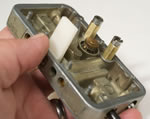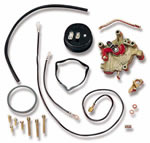Hib Halverson's Big Block From Hell Series
Hib Halverson's Big Block From Hell Series
 by Hib Halverson
by Hib Halverson
© December 2012
I bought the '71 Coupe which became the "Big Block from Hell" in 1980 in a smokin' deal from a guy in a club I was in back then, Corvettes Limited of Los Angeles. Ken Wright was his name and he was a big influence on the way I've been involved with the Corvette hobby. Ken died a number of years ago. I'm sure in that better place he's at, he's having a beer with Earnhardt. I'm still driving your old hot rod, Wright. Rest in peace, Dude.
I'll steal a phrase from Vice President Biden and tell you that, getting that car was a "...big f&%$ing deal!" Here I was—a kid with an affinity for burn-outs who'd hit the big time: a light car with big tires, 454 and a four-speed. Luckily, I didn't get in trouble (well—not too much) and, boy—did I have fun!
If you've read the other 16 parts of this series, you know the story of the engine in this car, but if you haven't, I'll summarize: by the mid-'90s, the stock, 365-horse 454 got boring, so I modified the engine with: overbore to 460 inches, steel crank, Crower Rods, 9.75:1 Bill Miller Engineering Forged Pistons, Crane mechanical-lifter roller cam (.567-in. lift and 234/244° duration at .050), DeGroff ported/polished heads with bigger valves, Crane dual valve springs, Crane roller rocker arms, an Edelbrock Performer RPM intake, Doug's Headers, MSD 6 ignition, a McLeod Racing aluminum flywheel and a McLeod "Street Twin" clutch. The engine makes about 550-hp at 6000-6200-rpm. I shift the car's Richmond "ROD" six-speed trans at 6500 rpm. The rev limiter is at 6750.
Sitting on the Performer RPM, that thing with four big holes in it is an 850 Holley—a classic, model 4150, "Double-Pumper" four-barrel carb. "DPs" come in five CFM ratings, 600 to 850. They have mechanical secondaries, dual accelerator pumps, on the 750 and 850, four idle mixture screws (aka, "four-corner idle") and a manual choke. Holley bills them as "...performance upgrades for streetable hot rods and race cars".
When their flow rating is matched to a C3 Vette's powertrain and weight, in a racing application, Double-Pumpers run well right out of the box, but what about part throttle, as in normal—ok..."sorta normal"—street driving? Well, putting it mildly...their drivability may leave something to be desired, as may their fuel economy because the stock DP calibration is intended for racing, not optimized street use.
Modifying Holley double pumpers for "double duty"—ie: performance along with better drivability and gas mileage—is a craft of vintage road racers, NASCAR crew chiefs and finicky hot rodders. Mastering this fusion of art and science is time-consuming, sometimes tedious work, but is, also, refreshingly "oldskool".
What changes might make a double-duty Double-Pumper?
1) Annular boosters in the primaries.
2) Smaller primary idle feed restrictions
3) Throttle plates with bypass holes
4) Smaller main jets and larger power valve channel restrictions
5) Changes in accelerator pumps, pump cams and pump discharge nozzles
Setting the Stage
While my 850 (PN R4781-5) dates to the mid-1990s, Holley still makes the 850 Double-Pumper in a slightly different version (PN R4781-8). It's recommended for engines of about 450 cubic inches with ported heads having large, but not huge, port volumes, big but not huge, cam profiles, headers and an RPM range of 2000-6500. It's intended for cars with short gears and either manual transmissions or automatics with high-stall converters.
Back in the '90s, the initial mods to my 850 were by the now-defunct Fuel Curve Engineering—see BBfH 14 for details. To improve fuel atomization and enhance low speed response, annular discharge boosters were installed in the primary barrels. Annular boosters are a slight restriction at high air flow, but I'll take that hit in exchange for better response.
The secondary barrels were polished and fitted with Fuel Curve Engineering boosters. To bridge the point where the secondary idle transfer circuit is saturated but the main circuit is not fully engaged, an intermediate circuit was added. Some believe this makes mechanical secondaries work better on the street. Others, such as Bob Verbancic, who runs the Carb Shop, a well-known performance carburetor speciality shop in Ontario, California, say the booster designs available today, coupled with proper main circuit calibration and accelerator pump choices makes three circuit secondaries obsolete and unnecessary. Since changing boosters and a new secondary metering block aren't in the budget right now, I'm sticking with the intermediate circuit, but my next carb might be different.
A choke is suggested for a Double-Pumper which has been calibrated for street use because the part-throttle air-fuel ratio of 14.5-15.5:1 needed for better gas mileage makes no-choke cold starts difficult. I like Holley's electric choke kit (p/n 45-224) because it eliminates fooling with a manual choke. To reduce restriction of air flow into the primary barrels in applications requiring a low air filter top due to limited hood clearance, the choke horn was milled to the minimum necessary to seal the choke plate.
Because special tools and a mill are required, modifications we've covered so far are seldom do-it-yourself operations and we suggest The Carb Shop for the work.



